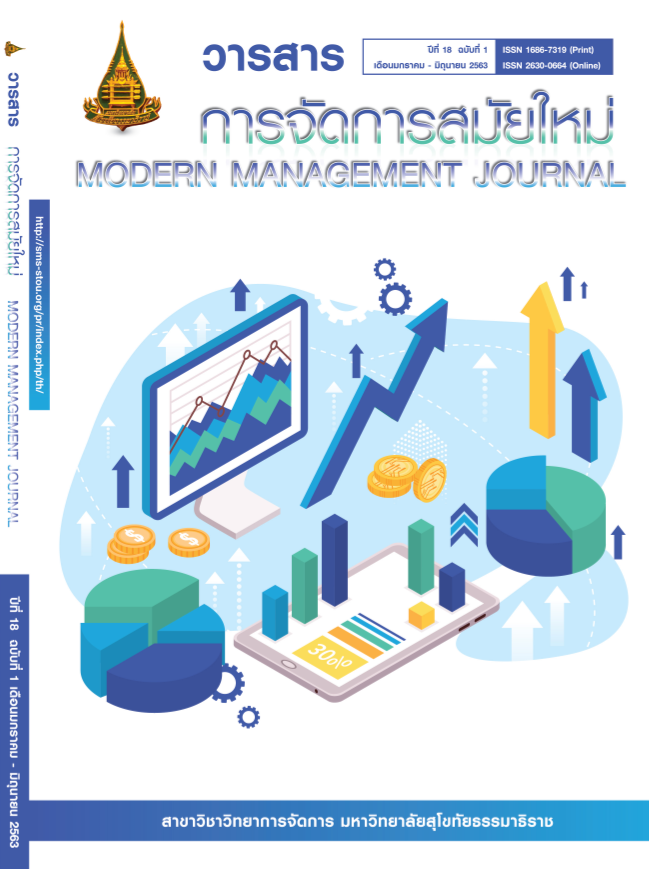INCREASING THE EFFICIENCY OF THE RESEARCH COMMERCIALIZATION PROCESS
Keywords:
University, Researchers, The Center of Intellectual Property and Business Incubator, EntrepreneursAbstract
This research analyzes how to increase the efficiency of the research commercialization process of Thammasat University. This research is qualitative research which studied the case study of Thammasat University consisting of 2 researchers, 2 officers of the Center of Intellectual Property and Business Incubator, and 1 entrepreneur. The research process comprises of three stages: 1) Reviewing the literature. 2) Conducting the empirical study by an in-depth interview with stakeholders. 3) Analyzing and concluding by using content analysis. The research found that Thammasat University has a research commercialization process in the form of a collaboration of three divisions; researchers, the Center of Intellectual Property and Business Incubator and entrepreneurs who have been supervised by "Thammasat University Regulations on Intellectual Property Rights and the Provision of Benefits from Intellectual Property of Thammasat University, 2018", These regulations consist of four chapters, namely; Chapter 1 Intellectual Property of the University, Chapter 2 Intellectual Property Management, Chapter 3 Exploitation of Intellectual Property of The University and, Chapter 4 Allocation or Sharing of Benefits. In some cases of the regulations, those who are involved may not have knowledge or understanding or may not be consistent in practice. Therefore, the university may provide knowledge to the researchers or those who are involved in the university’s regulations related to the research commercialization in each related category. As well as providing knowledge on intellectual property law, patent law, including regulations or guidelines for the Thammasat University's research commercialization to be clear and consistent with the practice to provide guidelines for those involved. In order to further enhance the university's research commercialization.
References
Alfons, B. (2010). Knowledge and the Regulation of Innovation. Poiesis & Praxis. 7(1/2), 73-86. https://doi.org/10.1007/s10202-010-0073-7.
Ambec, S., & Barla, P., (2006). Can environmental regulations be good for business? An assessment of the Porter hypothesis. Energy Stud. Rev. 14(2), 42-62. DOI: /10.15173/esr.v14i2.493.
Armando, E., Boaventura, G., Mauricio, J., Emanuela, T., Pereira, C., & Espinheira, C.(2017).Triple Helix Influence on Competitiveness Factors: Comparison between Wine Clusters in Brazil and Chile. Revista Electronica de Negocios Internacionais da ESPM. 12(3), 43-60. Retrieved from Academic Search Complete.
Bandarian, R. (2007). From Idea to Market in RIPI: An Agile Frame for NTD Process. Journal of Technology Management & Innovation. 2(1). Retrieved from J. Technol. Manag. Innov. 2007.
Banker, R. D., Bardhan, I., & Asdemir, O. (2006). Understanding the Impact of Collaboration Software on Product Design and Development. Information Systems Research. 17(4), 352-373. DOI: 10.1287/isre.1060.0104.
Belitski, M., Aginskaja, A., & Marozau, R. (2018). Commercializing University Research in Transition Economies: Technology Transfer Offices or Direct Industrial Funding ?. Research Policy. 48(3), 601-615. https://doi.org/10.1016/j.respol.2018.10.011.
Butenko, A., & Larouche, P., (2015). Regulation for Innovativeness or Regulation of Innovation?.Law, Innovation & Technology. 7(1), 52-82. https://doi.org/10.1080 /17579961.2015.1052643.
Department of Intellectual Property. (2017). Thai Intellectual Property Law. [On-line]. Available: https://www.ipthailand.go.th/th/dip-law-2.html.
Etzkowitz, H., & Leydesdorff, L. (2000). The Dynamics of Innovation: From National Systems and “Mode 2” to a Triple Helix of University–Industry–Government Relations. Res. Policy. 29(2), 109–123.
Guerrero, M., & Urbano, D. (2016). The Impact of Triple Helix Agents on Entrepreneurial Innovations' Performance: An Inside Look at Enterprises Located in an Emerging Economy. Technological Forecasting and Social Change. 119, 294-309. Retrieved from Science Direct.
Karaveg, C., Thawesaengskulthai, N., & Chandrachai, A. (2014). Evaluation Model for Research and Development Commercialization Capability. Production & Manufacturing Research. 2(1), 586-602. Retrieved from Tandfonline.
Lam, J. C. K., Hills, P., & Ng, C. K. W. (2012). Open Innovation: A Study of Industry-University Collaboration in Environmental R&D in Hong Kong. International Journal of Technology, Knowledge & Society. 8(6), 83-102. Retrieved from Academic Search Complete.
Leistyte, L. (2011). University Commercialization Policies and Their Implementation in The Netherlands and the United States. Science & Public Policy. 36(6). 437-448. Retrieved from Academic Search Complete.
Liu, Z., Mu, R., Hu, S., Li, W., & Wang, S. (2018). Intellectual Property Protection, Technological Innovation and Enterprise Value – An Empirical Study on Panel Data of 80 Advanced Manufacturing SMEs. Cognitive Systems Research. 52. 741-746. https://doi.org/10.1016/j.cogsys.2018.08.012.
Lounsbury, M., & Crumley, E.T., (2007). New Practice Creation: An Institutional Perspective on Innovation. Organ. Stud. 28 (7), 993-1012. https://doi.org/10.1177/0170840607078111.
Norman, G. A. V., & Eisenkot, R. (2017). Technology Transfer: From The Research Bench to Commercialization: Part 2 The Commercialization Process. JACC: Basic to Translational Science. 2(2), 197-208. https://doi.org/10.1016/j.jacbts.2017.03.004.
Patent Act, 1979. (1979). [On-line]. Available: https://www.wipo.int/edocs/lexdocs/laws/th/th/th007th.pdf.
Porter, M. E. (1985). Competitive Advantage: Creating and Sustaining Superior Performance. New York : Free Press. c1985.
Powers, J. B., & McDougall, P. P. (2005). University Start-up Formation and Technology Licensing With Firms That Go Public: A Resource-Based View of Academic Entrepreneurship. Journal of Business Venturing. 20(3), 291-311. https://doi.org/10.1016/j.jbusvent.2003.12.008.
Prasad, V. C. S. (2010) Variability Reduction for Commercialization of R&D Based Products. Ferroelectrics. 306, 2004(1), 273-281. https://doi.org/10.1080/00150190490460948.
Rasmussen, E. (2008). Government Instruments to Support The Commercialization of University Research: Lessons from Canada. Technonation. 28(8), 506-517. Retrieved from Science Direct.
Thammasat University. (2018). Thammasat University Regulations on Intellectual Property Rights and the Provision of Benefits from Intellectual Property of Thammasat University, 2018. (2018). [On-line]. Available: http://researchcenter.nurse.tu.ac.th/
Thammasat University. (2019). Thammasat University Regulations on Rules and Procedures for Establishing or Joining with other Persons to Establish A Juristic Person, A Type of Limited Company, 2019. (2019). [On-line]. Available: http://cwweb2.tu.ac.th/oth/council/quesdata/Data/M155.pdf.
Thongdetae, R. (2004). The Protection of Patent Cooperation treaty by WIPO. Bangkok: Faculty of Law, Thammasat University.
Ueasangkomsate, P., & Jangkot, A. (2017). Enhancing the Innovation of Small and Medium Enterprises in Food Manufacturing Through Triple Helix Agents. Kasetsart Journal of Social Sciences. https://doi.org/10.1016/j.kjss.2017.12.007.
Weckowska, D. M. (2014). Learning in University Technology Transfer Offices: Transactions-Focusedand Relations-Focused Approaches to Commercialization of Academic Research. Technovation. 41-42, 62-74. Retrieved from Science Direct.
Wonglimpiyarat, J (2017). Strategic Management of Technology. Bangkok: Publisher of Chulalongkorn University.
Downloads
Published
How to Cite
Issue
Section
License
Copyright (c) 2020 Modern Management Journal

This work is licensed under a Creative Commons Attribution-NonCommercial-NoDerivatives 4.0 International License.



